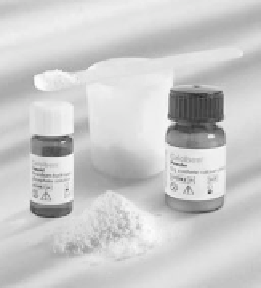Biomedical Engineering Reference
In-Depth Information
Figure 5.1
A presentation of two randomly chosen commercial calcium
orthophosphate cements.
5.3
Two Major Types of Calcium
Orthophosphate Cements
5.3.1
Apatite Cements
Typically, apatite cement formulations have a precipitated poorly
crystalline HA and/or CDHA as the end product of the setting
reaction (see chemical equations (5.1), (5.4-5.6)), although traces of
the unreacted starting materials can be present [106]. A FA-forming
cement is also known; it might be prepared by the same way but in the
presence of F
−
-ions [205]. Due to the initial presence of carbonates,
such commercial formulations as Norian SRS
®
and Biocement D
®
form a non-stoichiometric carbonatapatite or dahllite (Ca
(HPO
)
8.8
4
0.
) as the end product [53, 206]. As both CDHA
and carbonateapatite are formed in an aqueous environment and
have a low crystallinity, they appear to be similar to biological apatite
of bones and teeth. These properties are believed to be responsible
for their excellent
(PO
)
(CO
)
(OH)
7
4
4.5
3
0.7
1.3
resorption characteristics. Conventional
apatite cements contain TCP and/or TTCP phases in their powder
components [34], while a single component cement powder
consisting of K- and Na-containing CDHA is also available [17]. The
reactivity of TCP-based apatite cements varies as a function of TCP
crystal phase, crystallinity and particle size [207, 208]. Generally, a
higher reactivity is observed with a thermodynamically less stable
in vivo




Search WWH ::

Custom Search